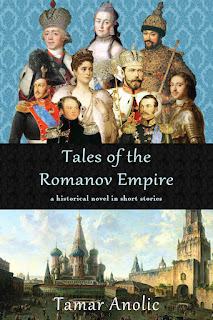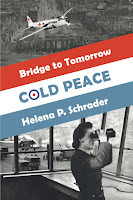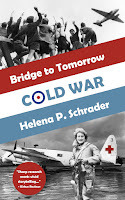"Why I Write Historical Fiction" -- A Guest Blogpost from Tamar Anolic
Tamar has always loved telling stories and started writing for fun as a teenager. Her favorite historical figures are the Romanovs, and she has written four novels about them. Perhaps this is natural, as she is the great-granddaughter of immigrants of mostly Russian origin. Tamar has also published a short story collection set in the Old West, The Lonely Spirit, which she turned into an audiobook last fall. When she isn’t writing, Tamar attends to her day job as a maritime and international trade lawyer.

I write historical fiction to tell untoldstories, and to tell stories of what might have been. I’ve always found fertileground for this in Russian history, and in the Romanovs in particular.
I first becameinterested in the Romanovs after my mom bought me a biography of Rasputin.Russia fascinated me because of its vastness and contradictions. At the heightof the Romanov empire, the country spanned one sixth of the world’s landmassand eleven time zones from Moscow to St. Petersburg all the way toVladivostok and the Pacific Ocean. The diversity in the population, too, wasenormous, both in terms of differences in wealth and class and in terms ofreligions and lifestyles. I drew on all of this in writing my novel in shortstories, Tales of the Romanov Empire.
The Romanovs ruledfor over three hundred years, but only a few of them are well known. Manypeople know Peter the Great, Catherine the Great, Nicholas and Alexandra andtheir son, the hemophiliac Alexei. Fewer people know Tsar Mikhail, the firstRomanov tsar- or that Mikhail was elected to the throne after sixteen years ofcivil war. Few people know that Mikhail and his son, Alexei, both came to thethrone when they were only sixteen. They also both held bride shows to findwives.
I started writinghistorical fiction because I wanted to tell these types of stories. In writingspecific chapters about so many of the Romanovs, I loved imagining the detailsof each event -- how did the shadows in the Kremlin move across Alexei’s face? Howcold was the palace when Mikhail awoke at four a.m. for the first religiousservice of the day?
I also foundMikhail’s ambassadors fascinating. The gifts he received from Iranian shahs andOttoman sultans meant that the world was interconnected in the 1600s in ways wedon’t hear much about today.
In addition, learningthat the Grand Duke Alexei, one of Alexander II’s sons, visited America andhunted out west with Buffalo Bill was incredible to me. The juxtaposition oflands and cultures was as evident in Alexei’s travels as it was between Mikhailand his ambassadors. Each of these stories became their own chapter in Talesof the Romanov Empire.
But the Grand DukeAlexei was not the only connection between the Romanovs and America for me. Mygreat-grandparents emigrated out of Eastern Europe, and all but one came fromRomanov territory. It is no secret that theRomanovs were virulently anti-Semitic, and their laws reflected that. Therewere statutes dictating where Jews could live (in the famous Pale ofSettlement, for example) and laws that forced Jews into the Romanovs’ army fora 25-year period. This was often a life sentence. Given that, and coupled withpogroms directed at Jews, it is no wonder that so many of them sought thesafety and freedom of American shores.
My great-grandfather, Wolf Anolic, was one of the peoplewho fled. I grew up on family stories about his running from conscription intothe Russian army, and of his arriving in New York City alone before he broughtthe rest of the family over. When I set out to write a book about the whole ofthe Romanov empire, I knew I would have to include a few chapters about him. It was magical to locate Wolf’s immigration record at Ellis Island,and to find pictures of the ship he sailed on to get there. Those chaptersproved to be some of the more gratifying ones I wrote.
The Romanovs’ pogromsalso have echoes in the spasms of violence we’re seeing in the world now. Thatis another aspect of why I write historical fiction- so many of today’sproblems have historical roots. We need to learn about the past and tell itsstories in order to find solutions now.
Of course, myfascination with the Romanovs also harkens back to the tragedy of the RussianRevolution, and what the Romanovs could have done to avoid it. At the sametime, I always wondered what kind of tsar Alexei, Nicholas II’s son, would havebeen. That’s why I wrote my other novels about the Romanovs -- the threealternate historical books in the Triumph of a Tsar series, which werepublished several years ago. I wanted to explore what might have been, andwriting those novels was a satisfying way of doing that.

Blog host Helena P. Schrader is an award-winning novelist, the author of six non-fiction and twenty historical fiction books. Her current project in a three-part series about the Berlin Airlift.
The first two volumes of the Bridge to Tomorrow Trilogy are now available.

The first battle of the Cold War is about to begin....
Berlin 1948. In the ruins ofHitler’s capital, former RAF officers, a woman pilot, and the victim of Russianbrutality form an air ambulance company. But the West is on a collision coursewith Stalin’s aggression and Berlin is about to become a flashpoint. World WarThree is only a misstep away. Buy Now
Berlin is under siege. More than twomillion civilians must be supplied by air -- or surrender to Stalin's oppression.
USAF Captain J.B. Baronowsky and RAF FlightLieutenant Kit Moran once risked their lives to drop high explosives on Berlin.They are about to deliver milk, flour and children’s shoes instead. Meanwhile,two women pilots are flying an air ambulance that carries malnourished andabandoned children to freedom in the West. Until General Winter deploys on theside of Russia. Buy now!
Based on historical events, award-winning and best-selling novelistHelena P. Schrader delivers an insightful, exciting and moving tale about howformer enemies became friends in the face of Russian aggression — and how closethe Berlin Airlift came to failing.
Winning a war with milk, coal and candy!



